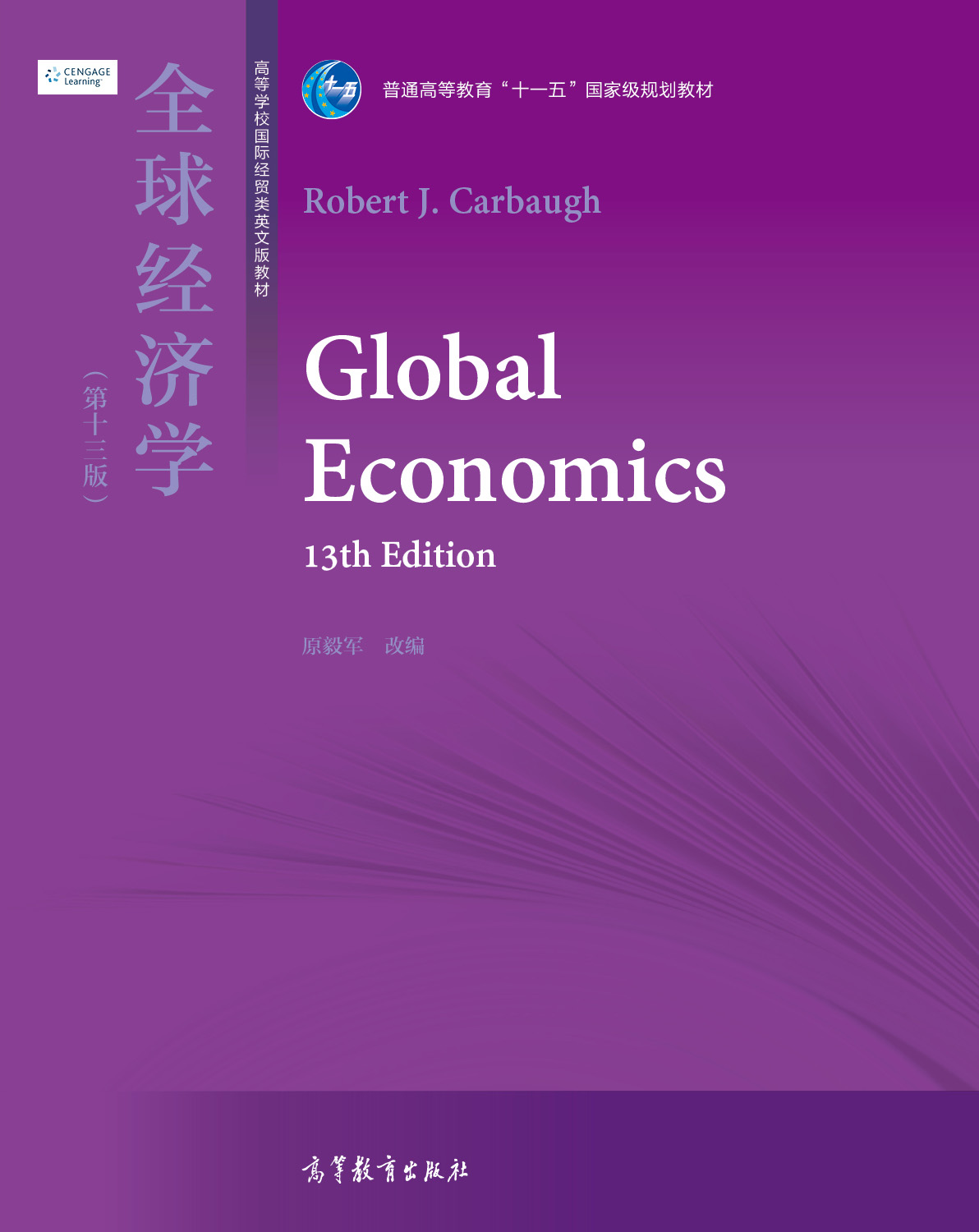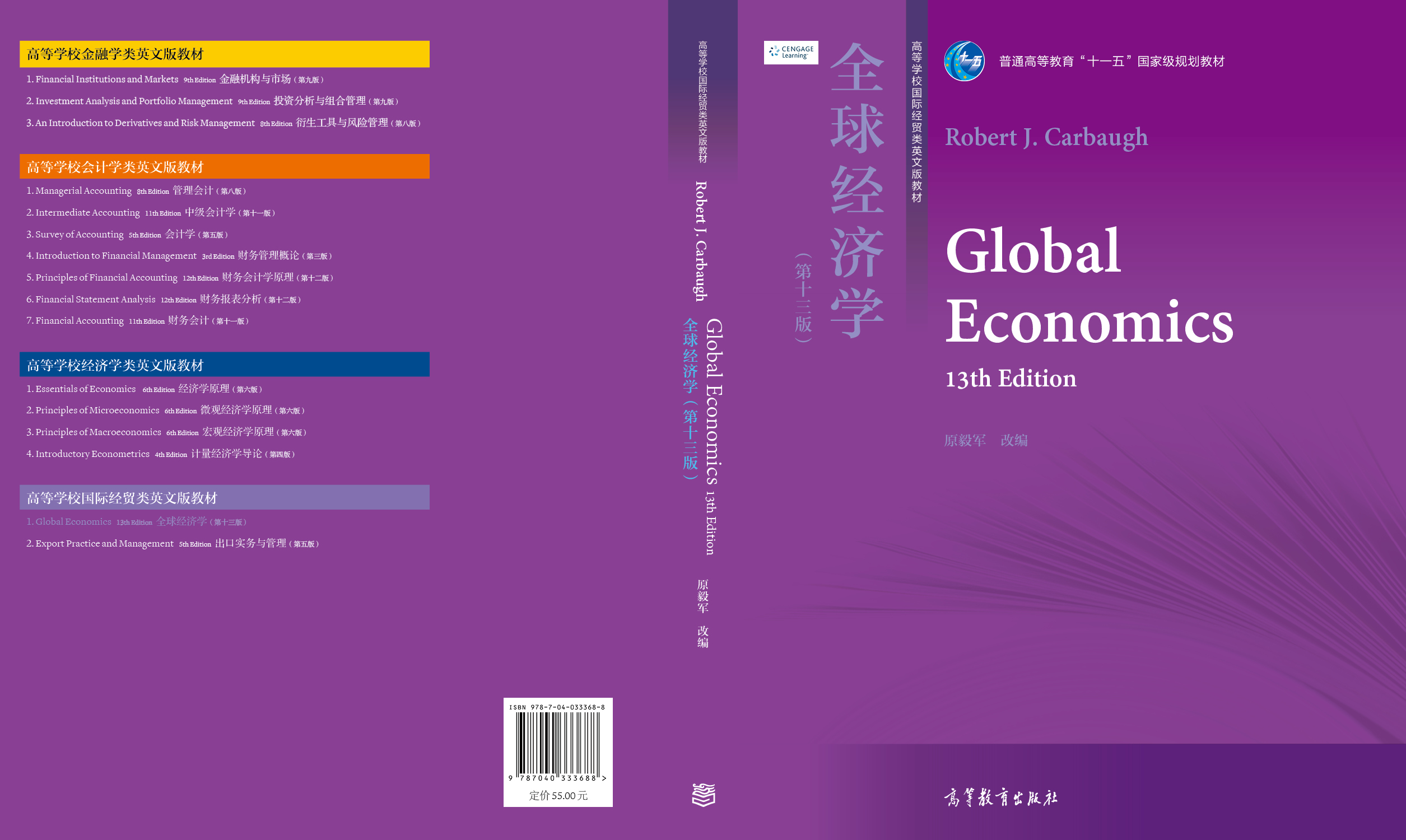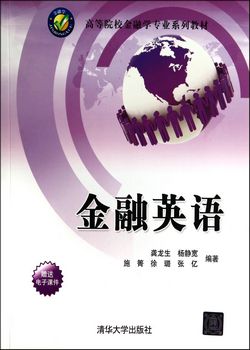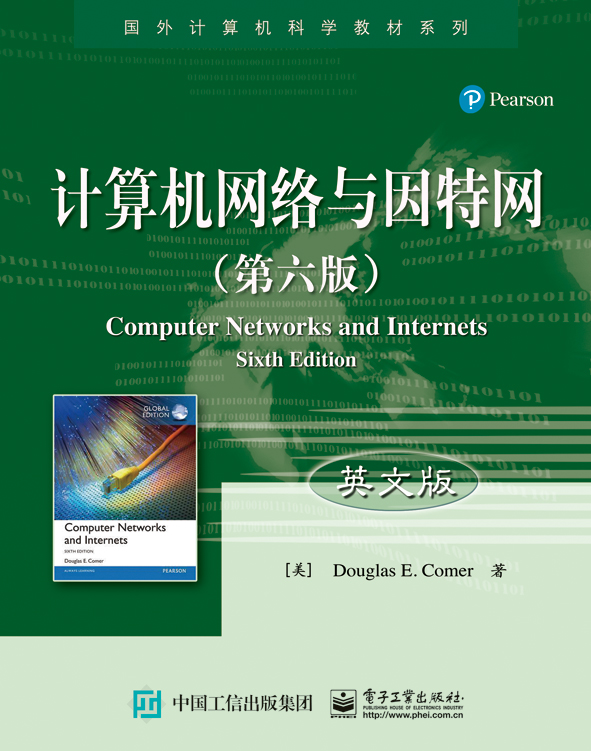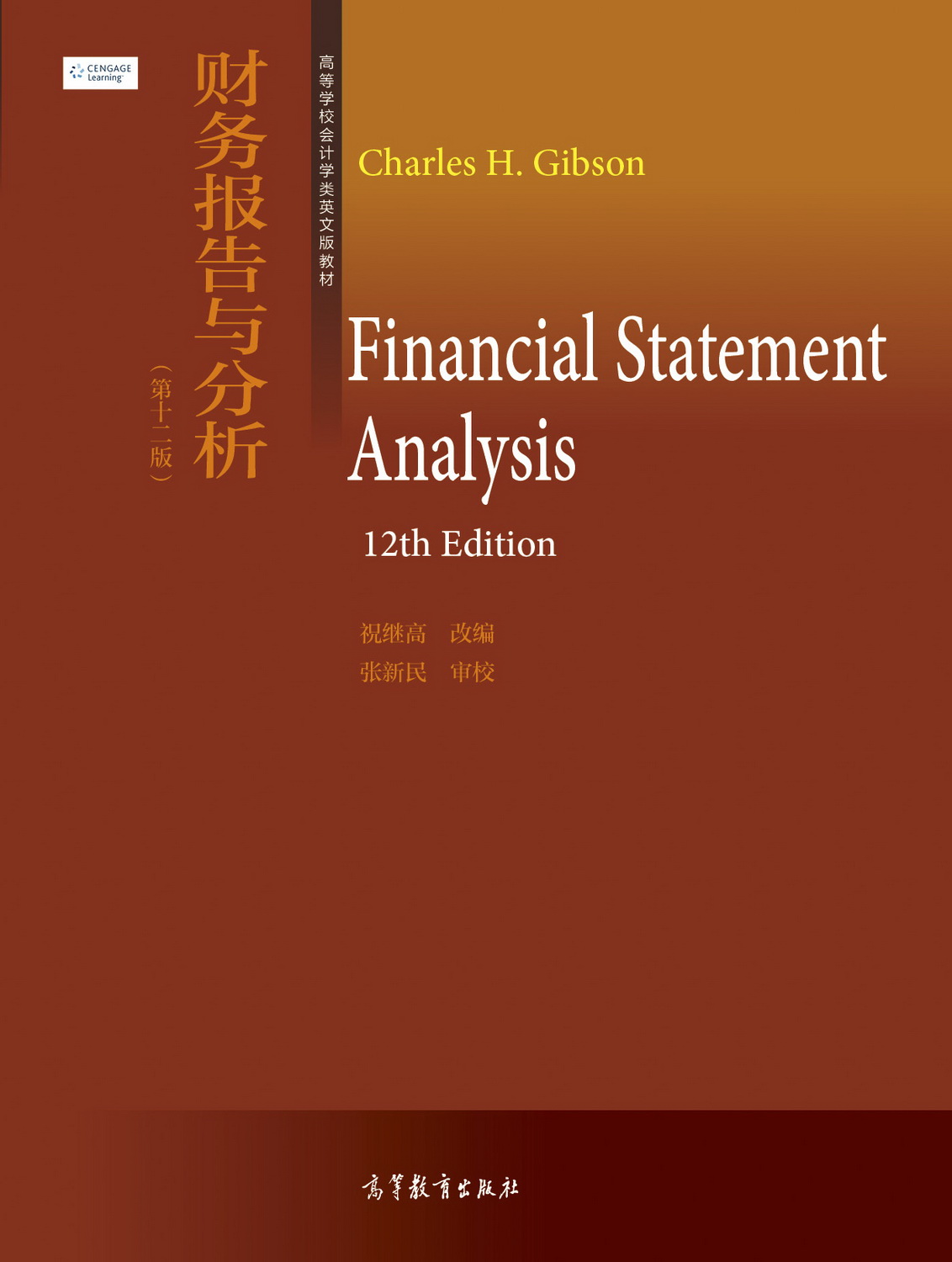全球经济学(Global Economics)(第十三版)
作者: Robert J. Carbaugh,原毅军改编
出版时间:2014-04
出版社:高等教育出版社
普通高等教育“十一五”国家级规划教材
- 高等教育出版社
- 9787040333688
- 1版
- 157829
- 60251019-0
- 平装
- 16开
- 2014-04
- 880
- 525
- 经济学
- 理论经济学
- F0
- 国际经济与贸易
- 本科
本书从两方面阐述了全球经济学理论:国际贸易关系和国际货币关系。全书由17章内容构成,系统论述了全球经济学领域内研究的六大热点问题,即2007—2009年间全球经济的衰退问题,经济活动的全球化问题,自由贸易和生活质量的关系问题,发展中国家与工业化国家之间的贸易冲突问题,世界贸易组织与区域性贸易协定角度的贸易自由化问题,以及作为世界储备货币的美元的作用和地位问题。全书的突出特点是紧密联系实践,理论和方法的阐述通俗易懂。如作者罗伯特·J.凯伯教授在本书的前言中所说:“我相信,把一门专业课的知识在实践中的应用讲授给学生,是激励他们学习这门课程的最好方式。”
本书非常适合我国高等院校经济管理专业本科生作为“国际经济学”课程配套教材使用,也可供从事全球经济学研究的人员参考。
前辅文
CHAPTER 1 The International Economy and Globalization
Globalization of Economic Activity
Waves of Globalization
First Wave of Globalization: 1870–1914
Second Wave of Globalization: 1945–1980
Latest Wave of Globalization
The United States as an Open Economy
Trade Patterns
Labor and Capital
Why Is Globalization Important?
The Global Recession of 2007–2009
Globalization: Increased Competition From Abroad
Bicycle Imports Force Schwinn to Downshift
Dell Sells Factories in Effort to Slash Costs
Common Fallacies of International Trade
Does Free Trade Apply to Cigarettes?
Is International Trade an Opportunity or a Threat to Workers?
Backlash Against Globalization
Summary
Study Questions
PART 1 International Trade Relations
CHAPTER2 Foundations of Modern Trade Theory: Comparative Advantage
Historical Development of Modern Trade Theory
The Mercantilists
Why Nations Trade: Absolute Advantage
Why Nations Trade: Comparative Advantage
David Ricardo
Production Possibilities Schedules
Trading Under Constant-Cost Conditions
Basis for Trade and Direction of Trade
Production Gains from Specialization
Consumption Gains from Trade
Distributing the Gains from Trade
Equilibrium Terms of Trade
Babe Ruth and the Principle of Comparative Advantage
Terms-of-Trade Estimates
Dynamic Gains From Trade
How Global Competition Led to Productivity Gains for US Iron Ore Workers
Changing Comparative Advantage
Trading Under Increasing-Cost Conditions
Increasing-Cost Trading Case
Partial Specialization
The Impact of Trade on Jobs
Comparative Advantage Extended to Many Products and Countries
More Than Two Products
More Than Two Countries
Exit Barriers
Empirical Evidence on Comparative Advantage
Does Comparative Advantage Apply in the Face of Job Outsourcing?
Advantages of Outsourcing
Outsourcing of Boeing 787 Dreamliner Triggers Machinist’s Strike
Outsourcing and the US Automobile Industry
Burdens of Outsourcing
Some US Manufacturers Prosper by Keeping Production in the United States
Summary
Study Questions
CHAPTER3 Sources of Comparative Advantage
Factor Endowments as a Source of Comparative Advantage
The Factor-Endowments Theory
Visualizing the Factor-Endowment Theory
Applying the Factor-Endowment Theory to US-China Trade
Factor-Price Equalization
Who Gains and Loses From Trade? The Stolper-Samuelson Theorem
Globalization Drives Changes for US Automakers
Is International Trade a Substitute for Migration?
Specific Factors: Trade and the Distribution of Income in the Short Run
Does Trade Make the Poor Even Poorer?
Skill as a Source of Comparative Advantage
Increasing Returns to Scale and Comparative Advantage
External Economies of Scale and Comparative Advantage
Overlapping Demands as a Basis for Trade
Intra-industry Trade
Technology as a Source of Comparative Advantage: The Product Cycle Theory
Radios, Pocket Calculators, and the International Product Cycle
Dynamic Comparative Advantage: Industrial Policy
Government Subsidies Support Boeing and Airbus
Government Regulatory Policies and Comparative Advantage
Transportation Costs and Comparative Advantage
Trade Effects
Rising Energy Costs Hinder Trade Flows
Falling Transportation Costs Foster Trade Boom
Summary
Study Questions
CHAPTER4 Tariffs
The Tariff Concept
Types of Tariffs
Specific Tariff
Ad Valorem Tariff
Compound Tariff
Effective Rate of Protection
Tariff Escalation
Outsourcing and Offshore-Assembly Provision
Dodging Import Tariffs: Tariff Avoidance and Tariff Evasion
Ford Strips Its Wagons to Avoid High Tariff
Smuggled Steel Evades US Tariffs
Postponing Import Tariffs
Bonded Warehouse
Foreign-Trade Zone
FTZ’s Benefit Motor Vehicle Importers
Tariff Effects: An Overview
Tariff Welfare Effects: Consumer Surplus and Producer Surplus
Tariff Welfare Effects: Small-Nation Model
Tariff Welfare Effects: Large-Nation Model
The Optimum Tariff and Retaliation
How a Tariff Burdens Exporters
Gains from Eliminating Import Tariffs
Steel Tariffs Buy Time for Troubled Industry
Tariffs and the Poor
Arguments for Trade Restrictions
Job Protection
Protection Against Cheap Foreign Labor
Fairness in Trade: A Level Playing Field
Maintenance of the Domestic Standard of Living
Equalization of Production Costs
Infant-Industry Argument
Noneconomic Arguments
Petition of the Candle Makers
The Political Economy of Protectionism
A Supply and Demand View of Protectionism
Summary
Study Questions
CHAPTER5 Nontariff Trade Barriers
Import Quota
Trade and Welfare Effects
Allocating Quota Licenses
Quotas Versus Tariffs
Tariff-Rate Quota: A Two-Tier Tariff
Sugar Tariff-Rate Quota Bittersweet for Consumers
Export Quotas
Japanese Auto Restraints Put Brakes on US Motorists
Domestic Content Requirements
Subsidies
Domestic Production Subsidy
How “Foreign” Is Your Car?
Export Subsidy
Dumping
Forms of Dumping
International Price Discrimination
Antidumping Regulations
Smith Corona Finds Antidumping Victories Are Hollow
Canadians Press Washington Apple Producers for Level Playing Field
Swimming Upstream: The Case of Vietnamese Catfish
Is Antidumping Law Unfair?
Should Average Variable Cost Be the Yardstick for Defining Dumping?
Should Antidumping Law Reflect Currency Fluctuations?
Are Antidumping Duties Overused?
Other Nontariff Trade Barriers
Government Procurement Policies
US Fiscal Stimulus and Buy American Legislation
Social Regulations
Sea Transport and Freight Regulations
Summary
Study Questions
CHAPTER6 Trade Regulations and Industrial Policies
US Tariff Policies Before 1930
Smoot-Hawley Act
Reciprocal Trade Agreements Act
General Agreement on Tariffs and Trade
Trade Without Discrimination
Promoting Freer Trade
Predictability: Through Binding and Transparency
Multilateral Trade Negotiations
World Trade Organization
Settling Trade Disputes
Does the WTO Reduce National Sovereignty?
Should Retaliatory Tariffs Be Used for WTO Enforcement?
Does the WTO Harm the Environment?
From Doha To Hong Kong: Failed Trade Negotiations
Trade Promotion Authority (Fast-Track Authority)
Safeguards (The Escape Clause): Emergency Protection From Imports
Countervailing Duties: Protection Against Foreign Export Subsidies
Lumber Duties Hammer Home Buyers
Antidumping Duties: Protection Against Foreign Dumping
Remedies Against Dumped and Subsidized Imports
US Steel Companies Lose an Unfair Trade Case and Still Win
Section 301: Protection Against Unfair Trading Practices
Protection of Intellectual Property Rights
Trade Adjustment Assistance
Will Wage and Health Insurance Make Free Trade More Acceptable to Workers?
Industrial Policies of the United States
Export Promotion and Financing
Industrial Policies of Japan
Strategic Trade Policy
Economic Sanctions
Factors Influencing the Success of Sanctions
Do Automaker Subsidies Weaken the WTO?
Summary
Study Questions
CHAPTER7 Trade Policies for the Developing Nations
Developing-Nation Trade Characteristics
Tensions Between Developing and Advanced Nations
Trade Problems of the Developing Nations
Unstable Export Markets
Falling Commodity Prices Threaten Growth of Exporting Nations
Worsening Terms of Trade
Limited Market Access
Agricultural Export Subsidies of Advanced Nations
Stabilizing Primary-Product Prices
Production and Export Controls
Buffer Stocks
Multilateral Contracts
Does the Fair-Trade Movement Help Poor Coffee Farmers?
The OPEC Oil Cartel
Maximizing Cartel Profits
OPEC as a Cartel
Are International Labor Standards Needed to Prevent Social Dumping?
Aiding the Developing Nations
The World Bank
International Monetary Fund
Generalized System of Preferences
Does Aid Promote Growth of Developing Nations?
How to Bring Developing Nations in From the Cold
Economic Growth Strategies: Import Substitution Versus Export-Led Growth
Import Substitution
Import-Substitution Laws Backfire on Brazil
Export-Led Growth
Is Economic Growth Good for the Poor?
Can All Developing Nations Achieve Export-Led Growth?
East Asian Economies
Flying-Geese Pattern of Growth
Summary
Study Questions
CHAPTER8 Regional Trading Arrangements
Regional Integration Versus Multilateralism
Types of Regional Trading Arrangements
Missing Benefits: The United States Falls Behind on Trade Liberalization
Impetus for Regionalism
Effects of a Regional Trading Arrangement
Static Effects
Did the United Kingdom (UK) Gain from Entering the European Union?
Dynamic Effects
The European Union
Pursuing Economic Integration
French and Dutch Voters Sidetrack Integration
Agricultural Policy
Economic Costs and Benefits of a Common Currency: The European Monetary Union
Optimum Currency Area
Europe as a Suboptimal Currency Area
Challenges for the EMU
The Euro, Ten Years Later: How Has It Performed?
Does the Eurozone Need a Bailout Fund?
North American Free Trade Agreement
NAFTA’s Benefits and Costs for Mexico and Canada
NAFTA’s Benefits and Costs for the United States
NAFTA and Trade Diversion: Textiles and Apparel
Is NAFTA an Optimum Currency Area?
From NAFTA to CAFTA
Free Trade Area of the Americas
Asia-Pacific Economic Cooperation
Transition Economies
The Transition Toward a Market-Oriented Economy
Russia and the World Trade Organization
Summary
Study Questions
CHAPTER9 International Factor Movements and Multinational Enterprises
The Multinational Enterprise
Motives for Foreign Direct Investment
Demand Factors
Do US Multinationals Exploit Foreign Workers?
Cost Factors
Supplying Products to Foreign Buyers: Whether to Produce Domestically or Abroad
Direct Exporting versus Foreign Direct Investment/Licensing
Foreign Direct Investment versus Licensing
Country Risk Analysis
International Trade Theory and Multinational Enterprise
Japanese Transplants in the US Automobile Industry
International Joint Ventures
Welfare Effects
Multinational Enterprises as a Source of Conflict
Employment
Technology Transfer
National Sovereignty
Balance of Payments
Transfer Pricing
Does the US Tax Code Send American Jobs Offshore?
International Labor Mobility: Migration
The Effects of Migration
Immigration as an Issue
Does US Immigration Policy Harm Domestic Workers?
Do Immigrants Really Hurt American Workers’ Wages?
Summary
Study Questions
PART 2 International Monetary Relations
CHAPTER10 The Balance of Payments
Double-Entry Accounting
International Payments Process
Balance-of-Payments Structure
Current Account
Capital and Financial Account
Statistical Discrepancy: Errors and Omissions
US Balance of Payments
The Paradox of Capital Flows from Developing to Industrial Countries
What Does a Current Account Deficit (Surplus) Mean?
Net Foreign Investment and the Current Account Balance
Impact of Capital Flows on the Current Account
Is a Current Account Deficit a Problem?
Business Cycles, Economic Growth, and the Current Account
Economic Downturn of 2007–2009: Effect on Foreign Investment in the United States
How the United States Has Borrowed at Very Low Cost
Do Current Account Deficits Cost Americans Jobs?
Can the United States Continue to Run Current Account Deficits Indefinitely?
Balance of International Indebtedness
United States as a Debtor Nation Summary
Study Questions
CHAPTER11 Foreign Exchange
Foreign-Exchange Market
Types of Foreign-Exchange Transactions
Interbank Trading
Reading Foreign-Exchange Quotations
Forward and Futures Markets
Foreign-Currency Options
Exchange-Rate Determination
Demand for Foreign Exchange
Weak Dollar Is a Bonanza for European Tourists
Supply of Foreign Exchange
Equilibrium Rate of Exchange
Indexes of the Foreign-Exchange Value of the Dollar: Nominal and Real Exchange Rates
Arbitrage
The Forward Market
The Forward Rate
Relation Between the Forward Rate and Spot Rate
Managing Your Foreign Exchange Risk: Forward Foreign-Exchange Contract
How Markel Rides Foreign-Exchange Fluctuations
Volkswagen Hedges Against Foreign-Exchange Risk
Does Foreign-Currency Hedging Pay Off?
Exchange-Rate Risk: The Hazard of Investing Abroad
Interest Arbitrage
Uncovered Interest Arbitrage
Covered Interest Arbitrage
Foreign-Exchange Market Speculation
How to Play the Falling (Rising) Dollar
Foreign Exchange Trading as a Career
Foreign Exchange Traders Hired by Commercial Banks, Companies, and Central Banks
Currency Markets Draw Day Traders
Summary
Study Questions
CHAPTER12 Exchange-Rate Determination
What Determines Exchange Rates?
Determining Long-Term Exchange Rates
Relative Price Levels
Relative Productivity Levels
Preferences for Domestic or Foreign Goods
Trade Barriers
Inflation Rates, Purchasing Power Parity, and Long-Term Exchange Rates
Law of One Price
The “Big Mac” Index and the Law of One Price
Purchasing Power Parity
Determining Short-Term Exchange Rates: The Asset-Market Approach
Inflation Differentials and the Exchange Rate
Relative Levels of Interest Rates
Expected Change in the Exchange Rate
Diversification, Safe Havens, and Investment Flows
The Ups and Downs of the Dollar
The 1980s
The 1990s
The First Decade of the 2000s
Exchange-Rate Overshooting
Forecasting Foreign-Exchange Rates
Judgmental Forecasts
Technical Forecasts
Fundamental Analysis
International Comparisons of GDP: Purchasing Power Parity
Comercial Mexicana Gets Burned By Speculation
Summary
Study Questions
CHAPTER13 Mechanisms of International Adjustment
Price Adjustments
Gold Standard
Quantity Theory of Money
Current-Account Adjustment
Financial Flows and Interest-Rate Differentials
CHAPTER14 Exchange-Rate Adjustments and the Balance of Payments
Effects of Exchange-Rate Changes on Costs and Prices
Japanese Firms Outsource Production to Limit Effects of Strong Yen
Cost-Cutting Strategies of Manufacturers in Response to Currency Appreciation
Appreciation of the Yen: Japanese Manufacturers
Appreciation of the Dollar: US Manufacturers
Will Currency Depreciation Reduce a Trade Deficit? The Elasticity Approach
J-Curve Effect: Time Path of Depreciation
Exchange Rate Pass-Through
Partial Exchange Rate Pass-Through
Invoice Practices
Market Share Considerations
Distribution Costs
Why a Dollar Depreciation May Not Close the US Trade Deficit
The Absorption Approach to Currency Depreciation
The Monetary Approach to Currency Depreciation
Summary
Study Questions
CHAPTER15 Exchange-Rate Systems and Currency Crises
Exchange-Rate Practices
Choosing an Exchange Rate System: Constraints Imposed by Free Capital Flows
Fixed Exchange-Rate System
Use of Fixed Exchange Rates
Par Value and Official Exchange Rate
Exchange-Rate Stabilization
Devaluation and Revaluation
Bretton Woods System of Fixed Exchange Rates
Floating Exchange Rates
Achieving Market Equilibrium
Trade Restrictions, Jobs, and Floating Exchange Rates
Arguments for and Against Floating Rates
Managed Floating Rates
Managed Floating Rates in the Short and Long Terms
Exchange-Rate Stabilization and Monetary Policy
Is Exchange-Rate Stabilization Effective?
The Crawling Peg
Currency Crises
Sources of Currency Crises
Speculators Attack East Asian Currencies
Capital Controls
Should Foreign-Exchange Transactions Income Adjustments
Disadvantages of Automatic Adjustment Mechanisms
Monetary Adjustments
Summary
Study Questions
CHAPTER16 Macroeconomic Policy in an Open Economy
Economic Objectives of Nations
Policy Instruments
Aggregate Demand and Aggregate Supply:A Brief Review
Monetary and Fiscal Policy Respond to Financial Turmoil in the Economy
Monetary and Fiscal Policy in a Closed Economy
Monetary and Fiscal Policy in an Open Economy
Does Crowding Occur in an Open Economy?
Effect of Fiscal and Monetary Policy Under Fixed Exchange Rates
Effect of Fiscal and Monetary Policy Under Floating Exchange Rates
Macroeconomic Stability and the Current Account: Policy Agreement Versus Policy Conflict
Inflation With Unemployment
International Economic-Policy Coordination
Policy Coordination in Theory
Does Policy Coordination Work?
Summary
Study Questions
CHAPTER17 International Banking: Reserves, Debt, and Risk
Nature of International Reserves
Demand for International Reserves
Exchange-Rate Flexibility
Other Determinants
Supply of International Reserves
Foreign Currencies
Should SDRs Replace the Dollar as the World’s Reserve Currency?
Gold
International Gold Standard
Gold Exchange Standard
Demonetization of Gold
Special Drawing Rights
Facilities for Borrowing Reserves
IMF Drawings
General Arrangements to Borrow
Swap Arrangements
International Lending Risk
The Problem of International Debt
Dealing with Debt-Servicing Difficulties
Reducing Bank Exposure to Developing-Nation Debt
Debt Reduction and Debt Forgiveness
The Eurodollar Market
Summary
Study Questions
Glossary

